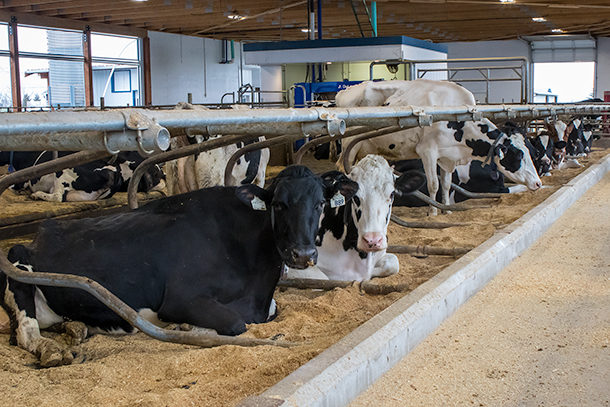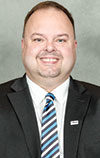Tip 1: Improve the stall surface
When cows are not provided with a comfortable place to rest, they will not use or occupy the stalls well. Hock injuries are commonly observed in situations where cows are forced to lie on a hard surface or when insufficient bedding is provided.
Bedding helps minimize friction between the hock and the stall surface. Even when mattresses or mats are used, inadequate bedding may also lead to hock injuries and poor stall use. This problem is worsened when the mattress cushions have lost their flexibility and are used past their useful life. Supplying a comfortable, soft surface cushion may be the most important factor affecting stall usage and lying time. An ideal stall bed conforms to the cow's shape, provides cushion while the cow is getting up and lying down, maintains effective traction to minimize slipping and remains dry to minimize bacterial growth and promote optimal udder health.
Many different combinations of stall bases and bedding types can be effective; however, sand bedding generally best meets the cows’ needs. Stall usage and lying time tends to be higher for sand-bedded freestalls than for mattress freestalls. Well bedded sand stalls are the gold standard for cow comfort in freestalls.
Keeping sand filled to the top of the curb increases stall use. Although mattresses, waterbeds and mats may reduce the amount of bedding needed, bedding still must be used to minimize friction while the cow rises from the stall and to absorb moisture. The solution to hock injury may often be as simple as using more bedding. This is particularly true for sand. Sand provides such a good resting material for cows that it will often mask other freestall design limitations. Hard or worn-out surfaces may need to be replaced with deep-bedded sand or new mattresses or waterbeds.
The useful life of mattresses is typically less than 10 years. Mattress quality varies considerably. The added cost of a quality mattress easily pays off across time compared to cheaper, lower quality or used mattresses. In a deep-bedded scenario without a mattress or mat, a minimum of 6 inches of bedding material is required. When mattresses or mats are used, at least 3 inches of bedding must be added to the top of the stall base.
Freestalls should be groomed, removing manure and wet areas two to three times per day. Deep-bedded stalls should be leveled at least twice per week. Bedding should be added at least once per week and possibly once per day depending on the type of bedding used, environmental conditions and observations of cow cleanliness.
Tip 2: Changing neck rail position
One way we can evaluate neck rail placement is by observing cows for perching behavior. "Perching" refers to when cows stand with their front feet in the stall and their rear feet in the alley behind the stall.
Generally, this behavior indicates improper neck rail placement. When the neck rail is too low, cows will sometimes stand with their head above the neck rail. If the bottom side of the neck rail has a polished appearance, the cows are likely hitting their neck against the neck rail when rising from the stall. If neck rails are too low, cows may also be hesitant to enter the stalls and have difficulty standing up. When the neck rail is too close to the rear of the stall, cows may lie diagonally rather than parallel to the length of the stall. If cows do not have enough space to lie down because the neck rail is too far back, hock injuries may be observed. Early freestall designs recommended a much shorter neck rail height than we recommend today; however, experience and research have shown that these older recommendations were incorrect.
The neck rail helps position the cow when she enters the stall, when she is standing in the stall or before or after standing up. Additionally, the neck rail helps encourage cows to preserve lunge space. When the neck rail is in the proper position, cows will stand with all four feet placed squarely within the stall, level backs and the top of their necks gently touching the neck rail.
In many situations, the neck rail can be moved without any major modifications. In some situations, it may be possible to move the entire stall divider up, though caution must be used to make sure that the distance between the divider and the stall base does not leave opportunity for cows to become lodged beneath the stall divider.
Increasing or decreasing the neck rail length involves unbolting the neck rail and moving it forward or backward along the stall divider to the desired length. Increasing the neck rail height may be a bit more challenging. Dairy producers should use their engineering ingenuity to determine the best modification for their facility. Wood blocks, box steel, welded pipe fixtures and clamps are examples of strategies used to raise neck rail height.
Tip 3: Remove lunging obstacles
Forward lunge space is often blocked by walls, boards or cables directly in front of the cows’ heads.
Generally, cows prefer to lunge forward when rising from a resting position. Thus, when obstructions are placed in front of the cows, there is no room for their heads to go in this natural rising motion. When cows do not have the ability to lunge forward, they may have difficulty rising from stalls. They may even become trapped against the wall while rising from the stall. Stalls must be long enough to allow cows to lunge forward when rising from the stall. Cows prefer to lunge forward rather than lunge to the side. To provide the cow with adequate forward lunge space, give 30 to 44 inches of space ahead of where their front knee is positioned while resting. Therefore, closed front stalls (such as stalls that face an outside wall) should be at least 1 foot longer than open front stalls to preserve this lunge space.
The key to solving this problem is to remove the lunging obstacles. For head-to-head stalls or inside stalls, remove walls and boards that may impede lunging. Depending on how the stall dividers are attached to the support structure, removing these obstacles may require moving posts or modifying where the stall dividers are attached. If the stalls are located on an outside wall, building a sloping adjustable sidewall curtain support along the outside wall will give the cows ample opportunity to lunge forward while still protecting cows from adverse weather.
Avoid piling bedding in front of the stall as this can unintentionally block lunge space. Some producers express concern that with open-front, head-to-head stalls, cows may attempt to go through the section between the stalls into the facing stall. This situation can lead to injury or cows restrained between the stalls. To remedy this problem, a deterrent bar, cable, rope or strap may be placed 40 to 42 inches above the stall surface in 16-foot stalls (two rows of head-to-head 8-foot stalls) or 34 to 36 inches above the stall surface in 18-foot stalls (two rows of head-to-head 9-foot stalls). When this deterrent is placed too low, it can also block lunge space.
Tip 4: Consider a brisket locator
The brisket locator is one of the more controversial and misunderstood aspects of freestall barn design. Having a brisket locator is not a requirement for a freestall. Cow comfort is likely better without a brisket locator, and research shows higher lying times without a brisket locator. Farms that are meticulous about managing bedding levels may not need a brisket locator. However, many farms find that the brisket locator improves cow cleanliness. Without a brisket locator, nothing stops the cow from lying or moving too far forward in the stall. This often leads to dirty stalls, dirty cows, increased SCC and increased clinical mastitis.







